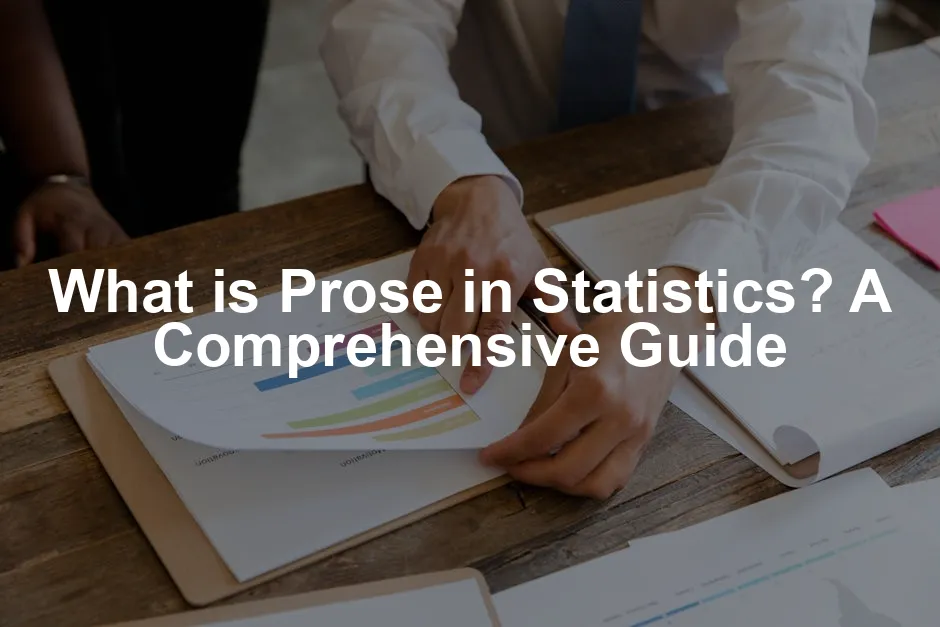- Avoid Jargon: Use plain language that is easy to understand. If technical terms are necessary, explain them simply.
- Use Examples: Illustrate complex ideas with relatable examples. This helps readers grasp difficult concepts.
- Practice Active Voice: Active voice makes sentences stronger and more direct. Instead of “The data was analyzed,” say “We analyzed the data.”
- Keep Sentences Short: Aim for brevity. Short sentences enhance readability and comprehension.
- Organize Logically: Present information in a structured manner, guiding readers through your narrative.

Types of Prose in Statistical Writing
Fictional vs. Non-Fictional Prose
Prose can be divided into two main categories: fictional and non-fictional. Fictional prose includes narratives created from the imagination. Think novels and short stories. They often explore themes, characters, and settings that may not exist in reality. For example, “The Great Gatsby” by F. Scott Fitzgerald transports readers into the Roaring Twenties, complete with extravagant parties and tragic romances. On the other hand, non-fictional prose deals with facts and real events. This form includes research papers, essays, and journalistic articles. For instance, a study published in a medical journal analyzing the effects of a new drug is non-fictional prose. It presents data, findings, and interpretations based on actual research rather than imagination. In the world of statistics, non-fictional prose reigns supreme. It’s crucial for data reporting, where clarity and accuracy are paramount. Researchers and statisticians use this form to communicate findings effectively. When writing a research paper, for example, a statistician might present their results in straightforward language. They might say, “The treatment improved patient outcomes by 20%,” instead of burying the finding in jargon. This approach makes the information accessible to a broader audience, including those who may not have a statistical background. And for those looking to understand statistical concepts better, consider How to Lie with Statistics by Darrell Huff. Non-fictional prose is also essential in academic writing. It helps convey complex statistical concepts in a comprehensible manner. A well-crafted research paper uses clear prose to explain methodologies, results, and implications. This is vital for peer reviews, where the clarity of prose can determine whether research is accepted or rejected. Moreover, in data reporting, non-fictional prose enhances transparency. For instance, a governmental report on unemployment rates needs to be clear and factual. It should provide the public with an understanding of economic conditions without unnecessary complexity. By focusing on straightforward language, statisticians can ensure that the information reaches the intended audience, promoting informed decision-making.
Prose Poetry and Its Application
Prose poetry is an intriguing hybrid form that combines elements of prose and poetry. It is written in paragraphs rather than verse, yet still employs poetic devices like imagery, metaphor, and rhythm. This unique style can be particularly useful in statistical contexts, as it engages readers while still conveying essential information. Consider a prose poem that describes statistical data in a vivid manner. For example: “In the year of the pandemic, numbers soared like wildfires. Each statistic told a story of loss and resilience, a testament to humanity’s struggle. The charts danced with curves, rising and falling, echoing the emotional tides of a world on edge.” This approach not only presents data but also evokes feelings, making the statistics more relatable. Using prose poetry in statistical writing can make complex data more engaging. It allows writers to break away from the rigid structures of traditional reporting. This can help capture the audience’s attention and foster a deeper connection to the material. A prose poem can transform dry figures into powerful narratives. Imagine a report on climate change statistics presented in prose poetry. Instead of listing percentages and figures, it could paint a picture of melting ice caps and rising sea levels. The data becomes a story—one that invites readers to reflect on the urgent realities of our environment. Moreover, prose poetry can be effective in grant proposals or presentations. By weaving statistical data into poetic descriptions, writers can create compelling arguments that resonate with decision-makers. Engaging prose poetry can inspire action and support for causes driven by data. And if you’re looking for a way to unwind while enhancing creativity, try an Adult Coloring Book for Stress Relief. In summary, prose poetry offers a creative way to convey statistical information. It merges clarity with artistic expression, allowing data to speak in compelling narratives. This blending of forms can enrich statistical writing, making it not only informative but also memorable.
Best Practices for Writing Prose in Statistics
Techniques for Clear Statistical Writing
Writing clear statistical prose requires intentional choices. Here are some practical techniques to enhance your writing:- Use Active Voice: Active voice makes sentences more direct and engaging. Instead of saying, “The data was analyzed by the researchers,” say, “The researchers analyzed the data.” This shifts the focus to the actor and makes the sentence stronger.
- Vary Sentence Lengths: Mix short and long sentences to create a natural rhythm. Short sentences can emphasize key points, while longer ones can provide context. For example: “The survey revealed significant findings. Participants indicated a preference for clarity in communication.”
- Ensure Logical Flow: Organize your writing logically. Start with an overview, then delve into details. Use headings and subheadings to guide readers. For instance, begin with an introduction to the topic, followed by methodology, results, and conclusions.
- Avoid Jargon: Minimize technical jargon. If you must use it, explain it in simple terms. For example, instead of saying “statistical significance,” try “the results are likely not due to chance.” This approach makes your writing accessible to a broader audience.
- Use Examples: Concrete examples can clarify complex concepts. For instance, when discussing averages, explain how they represent a typical value among a group. “The average height of participants was 5’8″, indicating most individuals are around this height.” This contextualizes the data for readers.
- Incorporate Visual Aids: Charts and graphs can complement your prose. When discussing trends, refer to a graph: “As shown in Figure 1, the unemployment rate decreased steadily over the year.” This visual support enhances understanding and retention.
- Edit Ruthlessly: Revise your work. Remove unnecessary words and phrases. A polished draft is more effective. For example, change “The results of the study indicate that there is a possibility of a correlation” to “The study suggests a correlation.”
- Read Aloud: Reading your prose aloud helps identify awkward phrasing or unclear sections. If a sentence doesn’t sound right, rewrite it. This practice enhances flow and clarity.
- “In the 2023 study, 60% of respondents reported feeling more productive while working from home.” – This sentence is clear and direct, providing a specific finding without ambiguity.
- “Over the past decade, the average temperature in the region has risen by 2 degrees Fahrenheit, highlighting the impact of climate change.” – Here, the sentence effectively connects data to broader implications.
- “The survey results showed that 75% of participants preferred online shopping due to its convenience.” – This example emphasizes the finding while using straightforward language.

Common Mistakes to Avoid
When writing statistical prose, certain pitfalls can obscure your message. Here are common mistakes and strategies to avoid them:- Overcomplicating Language: Avoid using unnecessarily complex language. For instance, writing “The respondents exhibited a proclivity towards favoring online shopping” is convoluted. Instead, say, “Most respondents preferred online shopping.” Simplifying your language enhances clarity.
- Misrepresenting Data: Be careful not to distort data for effect. Present statistics honestly and accurately. For example, saying “90% of participants enjoyed the event” is misleading if only ten people attended. Always provide context to your data to avoid misrepresentation.
- Ignoring Audience: Tailor your writing to your audience. If your readers are not familiar with statistical terms, avoid jargon. Instead of “confidence interval,” say “the range where we expect the true value to fall.” This makes your work more approachable.
- Lack of Structure: Failure to organize your writing can confuse readers. Use headings and bullet points to break down complex information. For example, when discussing findings, use bullet points to list key statistics clearly.
- Neglecting to Cite Sources: Always cite your data sources. Without proper attribution, your work lacks credibility. For example, “According to the 2022 National Health Survey, 70% of adults exercise regularly” is effective when supported by a citation.
- Being Overly Verbose: Long-winded explanations can lose readers’ interest. Aim for brevity. Instead of saying, “It is important to note that the majority of the participants indicated a preference,” say, “Most participants preferred.”
- Failing to Review: Editing is crucial. Spelling or grammatical errors undermine your professionalism. Always proofread your work or consider peer reviews. A fresh set of eyes can catch mistakes you might overlook.
- Ignoring Feedback: Constructive criticism is invaluable. If peers suggest changes, consider their perspective. Feedback can help refine your prose and enhance clarity.

Conclusion
In conclusion, prose is the backbone of effective statistical writing. It is not merely the vehicle for numbers; it translates data into stories that everyone can understand. Throughout this article, we’ve explored how prose enhances clarity, making complex statistical findings accessible. It provides a bridge between intricate data and the reader’s comprehension, ensuring that key insights don’t get lost in a sea of numbers. The significance of good prose in statistics cannot be overstated. Clear and engaging prose helps avoid misunderstandings, misinterpretations, and misrepresentations of data. It transforms raw statistics into narratives that spark interest and facilitate informed decisions. When done right, prose can make statistical reporting engaging rather than overwhelming, inviting readers to appreciate the nuances of data. We’ve also discussed the essential elements of prose, including clarity, conciseness, and coherence. These principles are not just recommendations; they are the foundation of effective statistical communication. By applying these elements, writers can elevate their prose and, in turn, their statistical reports. As you move forward in your statistical endeavors, remember to prioritize good prose. Whether you’re drafting a report, writing an article, or presenting findings, let clarity and engagement guide your writing. Your audience will thank you for it, and your statistical insights will shine through. And if you’re in need of a good read to inspire you, consider The Signal and the Noise: Why So Many Predictions Fail—but Some Don’t by Nate Silver. So, grab your pen (or keyboard) and start applying these principles! Good prose is within your reach. Embrace it, and watch as your statistical writing becomes not just informative, but truly compelling.
FAQs
What is prose?
Prose refers to ordinary written or spoken language that follows standard grammatical structures. It’s organized into sentences and paragraphs without a metrical structure. For example, a straightforward statement like, “The cat sat on the mat,” is prose.
How does prose differ from poetry?
Prose and poetry differ significantly in structure and style. Prose is characterized by its use of sentences and paragraphs, focusing on clear communication. Poetry often employs meter, rhyme schemes, and line breaks, emphasizing artistic expression and sound patterns.
Why is prose important in statistics?
Prose is crucial in statistics as it enhances clarity and understanding. It transforms complex data into accessible narratives, allowing readers to grasp key findings without being overwhelmed by numbers or jargon.
What are some tips for improving my statistical prose?
To enhance your statistical prose, consider these tips: Use clear and straightforward language. Avoid jargon unless necessary, and explain it when used. Organize your writing logically, using headings and bullet points. Keep sentences concise and to the point. Revise and edit for clarity and coherence.
Can prose be creative in statistical writing?
Absolutely! While clarity is essential, there’s room for creativity in statistical prose. Using vivid examples, engaging narratives, and relatable analogies can help convey complex concepts more effectively. Balancing creativity and clarity will make your statistical writing more impactful.
For those preparing for exams, understanding effective prose in statistical reporting is crucial. Check out this AP Statistics Formula Sheet for essential tips.
All images from Pexels
Introduction
Prose in statistics is more than just a fancy term. It refers to the clear, direct manner of presenting information. Think of prose as the bridge connecting numbers and human understanding. In statistics, it transforms complex data into digestible narratives. Why is clear writing crucial in statistical reporting? Well, statistics can be intimidating. A labyrinth of numbers may leave readers scratching their heads. Prose alleviates this confusion. It clarifies findings, emphasizes key points, and guides readers through the data. Without effective prose, even the most groundbreaking statistics can fall flat. This article aims to unpack prose in statistics. We will define what prose means, explore its different types, and highlight its significance in statistical communication. By the end, you’ll see how prose is essential in reporting and analyzing data effectively. So, grab a cup of coffee, and let’s dive into the world of prose in statistics! And speaking of coffee, if you need a boost while writing, check out this Coffee Maker to keep you energized!
Understanding Prose
Definition of Prose
Prose is the ordinary form of written language. It’s what you read in books, articles, and reports—minus the rhyme and meter typical of poetry. Prose uses complete sentences and paragraphs, making it easy to follow. What sets prose apart is its straightforward structure. It’s like the difference between a casual chat and a lyrical poem. You won’t find stanzas or rhythmic patterns here. Instead, prose flows naturally, mirroring everyday speech. In statistics, prose serves a vital role. It explains complex concepts in simple terms, making data more accessible. When statisticians write their reports, they aim for clarity over artistry. The focus is on delivering information that readers can easily grasp and act upon. Now, how does prose differ from poetry? Poetry often employs creative language, rhythm, and imagery. It can evoke emotions and paint vivid pictures. Prose, on the other hand, prioritizes communication. It aims to inform, persuade, or narrate without the embellishments of poetry. In summary, prose is the go-to format for anyone looking to present ideas clearly. It’s not just about what you say; it’s about how you say it. And if you want to explore the art of statistics further, consider picking up The Art of Statistics: Learning from Data by David Spiegelhalter.
Historical Context of Prose
Prose has a rich history that stretches back centuries. It emerged as a contrast to poetry, allowing for more straightforward expression. Ancient orators like Cicero used prose to communicate complex ideas clearly. His speeches were legendary, and they set the groundwork for future prose writing. Fast forward to the Middle Ages, where figures like Geoffrey Chaucer began using prose in English literature. His works paved the way for prose narratives, making stories accessible to wider audiences. As time progressed, prose gained popularity, especially in the form of novels in the 18th century. The rise of the novel marked a significant shift. Prose was no longer seen as inferior to poetry; it became a respected literary form. Today, prose is the dominant mode of communication in literature and academia alike. It allows writers to convey thoughts, arguments, and data clearly and effectively. Understanding the historical context of prose helps us appreciate its importance in statistics. Just as prose evolved to meet the needs of communication, it adapts to present data in the most understandable way possible. In the world of statistics, where clarity is crucial, prose remains an invaluable tool. Embracing prose means embracing clarity and understanding. It’s about connecting with readers, ensuring they grasp the insights behind the numbers. After all, effective communication is the heart of statistics. And speaking of clarity, if you’re looking to improve your understanding of the numbers, grab a copy of Understanding Statistics.
The Role of Prose in Statistics
Importance of Prose in Statistical Writing
Prose plays a vital role in statistical writing. It transforms dry numbers into narratives that can be understood by a wider audience. Clear prose enhances the accessibility of statistical findings, bridging the gap between complex data and everyday understanding. Imagine reading a statistical report filled with jargon and convoluted sentences. Confusing, right? Effective prose simplifies this, guiding readers through intricate concepts. It breaks down statistics into manageable pieces, making them relatable and engaging. Consider a statistical report on health outcomes. Instead of stating, “The prevalence of diabetes increased by 5%,” an effective prose approach might say, “This year, five more people out of every hundred were diagnosed with diabetes.” This change makes the information relatable. It shifts the focus from abstract figures to real-world implications. And if you want to dive deeper into the nuances of statistics, check out Naked Statistics: Stripping the Dread from the Data by Charles Wheelan. Another example can be found in a report discussing unemployment rates. Rather than presenting a percentage increase, it could explain, “For every 100 workers, two lost their jobs,” allowing readers to visualize the impact. Prose helps paint a picture, making statistics resonate with readers. Moreover, prose can emphasize key findings. Using straightforward language, writers can highlight critical points, ensuring they stand out. This is essential when communicating results to stakeholders who may not have a statistical background. Additionally, effective prose fosters engagement. When readers can easily follow the narrative, they are more likely to absorb the information. A well-structured report with clear prose invites readers to explore the data further. It encourages questions, discussions, and deeper insights. And for those looking to enhance their analytical skills, consider Statistics for Dummies. The importance of prose in statistical writing cannot be overstated. It transforms numbers into stories, making statistics not just informative but also enjoyable. By prioritizing clarity and accessibility, writers can ensure their findings truly reach their audience.
Elements of Prose in Statistical Context
Prose in statistical writing is characterized by several key elements: clarity, conciseness, and coherence. Each of these elements plays a vital role in effectively communicating complex information. Clarity is the cornerstone of effective prose. It involves using straightforward language that avoids ambiguity. Jargon can alienate readers, causing confusion. Instead, writers should opt for familiar terms and simple explanations. For instance, instead of saying “statistical significance,” one might say “the results are likely not due to chance.” This simple shift enhances understanding and keeps the reader engaged. Conciseness is equally important. In statistical writing, every word matters. Writers should aim to convey their message in as few words as possible without sacrificing meaning. Long, winding sentences can lose readers’ attention. Instead, short, punchy sentences can deliver information more effectively. Consider this: “The results were significant” is clear and concise compared to “The statistical analysis yielded results that can be deemed statistically significant.” Coherence refers to the logical flow of ideas. A well-organized piece of writing guides readers from one point to the next. Each paragraph should connect to the overall narrative, creating a seamless reading experience. To achieve coherence, writers should use transitional phrases and ensure each section logically follows the previous one. This makes it easier for readers to follow complex arguments or data analyses. Here are some practical tips for writing effective statistical prose:- Avoid Jargon: Use plain language that is easy to understand. If technical terms are necessary, explain them simply.
- Use Examples: Illustrate complex ideas with relatable examples. This helps readers grasp difficult concepts.
- Practice Active Voice: Active voice makes sentences stronger and more direct. Instead of “The data was analyzed,” say “We analyzed the data.”
- Keep Sentences Short: Aim for brevity. Short sentences enhance readability and comprehension.
- Organize Logically: Present information in a structured manner, guiding readers through your narrative.

Types of Prose in Statistical Writing
Fictional vs. Non-Fictional Prose
Prose can be divided into two main categories: fictional and non-fictional. Fictional prose includes narratives created from the imagination. Think novels and short stories. They often explore themes, characters, and settings that may not exist in reality. For example, “The Great Gatsby” by F. Scott Fitzgerald transports readers into the Roaring Twenties, complete with extravagant parties and tragic romances. On the other hand, non-fictional prose deals with facts and real events. This form includes research papers, essays, and journalistic articles. For instance, a study published in a medical journal analyzing the effects of a new drug is non-fictional prose. It presents data, findings, and interpretations based on actual research rather than imagination. In the world of statistics, non-fictional prose reigns supreme. It’s crucial for data reporting, where clarity and accuracy are paramount. Researchers and statisticians use this form to communicate findings effectively. When writing a research paper, for example, a statistician might present their results in straightforward language. They might say, “The treatment improved patient outcomes by 20%,” instead of burying the finding in jargon. This approach makes the information accessible to a broader audience, including those who may not have a statistical background. And for those looking to understand statistical concepts better, consider How to Lie with Statistics by Darrell Huff. Non-fictional prose is also essential in academic writing. It helps convey complex statistical concepts in a comprehensible manner. A well-crafted research paper uses clear prose to explain methodologies, results, and implications. This is vital for peer reviews, where the clarity of prose can determine whether research is accepted or rejected. Moreover, in data reporting, non-fictional prose enhances transparency. For instance, a governmental report on unemployment rates needs to be clear and factual. It should provide the public with an understanding of economic conditions without unnecessary complexity. By focusing on straightforward language, statisticians can ensure that the information reaches the intended audience, promoting informed decision-making.
Prose Poetry and Its Application
Prose poetry is an intriguing hybrid form that combines elements of prose and poetry. It is written in paragraphs rather than verse, yet still employs poetic devices like imagery, metaphor, and rhythm. This unique style can be particularly useful in statistical contexts, as it engages readers while still conveying essential information. Consider a prose poem that describes statistical data in a vivid manner. For example: “In the year of the pandemic, numbers soared like wildfires. Each statistic told a story of loss and resilience, a testament to humanity’s struggle. The charts danced with curves, rising and falling, echoing the emotional tides of a world on edge.” This approach not only presents data but also evokes feelings, making the statistics more relatable. Using prose poetry in statistical writing can make complex data more engaging. It allows writers to break away from the rigid structures of traditional reporting. This can help capture the audience’s attention and foster a deeper connection to the material. A prose poem can transform dry figures into powerful narratives. Imagine a report on climate change statistics presented in prose poetry. Instead of listing percentages and figures, it could paint a picture of melting ice caps and rising sea levels. The data becomes a story—one that invites readers to reflect on the urgent realities of our environment. Moreover, prose poetry can be effective in grant proposals or presentations. By weaving statistical data into poetic descriptions, writers can create compelling arguments that resonate with decision-makers. Engaging prose poetry can inspire action and support for causes driven by data. And if you’re looking for a way to unwind while enhancing creativity, try an Adult Coloring Book for Stress Relief. In summary, prose poetry offers a creative way to convey statistical information. It merges clarity with artistic expression, allowing data to speak in compelling narratives. This blending of forms can enrich statistical writing, making it not only informative but also memorable.
Best Practices for Writing Prose in Statistics
Techniques for Clear Statistical Writing
Writing clear statistical prose requires intentional choices. Here are some practical techniques to enhance your writing:- Use Active Voice: Active voice makes sentences more direct and engaging. Instead of saying, “The data was analyzed by the researchers,” say, “The researchers analyzed the data.” This shifts the focus to the actor and makes the sentence stronger.
- Vary Sentence Lengths: Mix short and long sentences to create a natural rhythm. Short sentences can emphasize key points, while longer ones can provide context. For example: “The survey revealed significant findings. Participants indicated a preference for clarity in communication.”
- Ensure Logical Flow: Organize your writing logically. Start with an overview, then delve into details. Use headings and subheadings to guide readers. For instance, begin with an introduction to the topic, followed by methodology, results, and conclusions.
- Avoid Jargon: Minimize technical jargon. If you must use it, explain it in simple terms. For example, instead of saying “statistical significance,” try “the results are likely not due to chance.” This approach makes your writing accessible to a broader audience.
- Use Examples: Concrete examples can clarify complex concepts. For instance, when discussing averages, explain how they represent a typical value among a group. “The average height of participants was 5’8″, indicating most individuals are around this height.” This contextualizes the data for readers.
- Incorporate Visual Aids: Charts and graphs can complement your prose. When discussing trends, refer to a graph: “As shown in Figure 1, the unemployment rate decreased steadily over the year.” This visual support enhances understanding and retention.
- Edit Ruthlessly: Revise your work. Remove unnecessary words and phrases. A polished draft is more effective. For example, change “The results of the study indicate that there is a possibility of a correlation” to “The study suggests a correlation.”
- Read Aloud: Reading your prose aloud helps identify awkward phrasing or unclear sections. If a sentence doesn’t sound right, rewrite it. This practice enhances flow and clarity.
- “In the 2023 study, 60% of respondents reported feeling more productive while working from home.” – This sentence is clear and direct, providing a specific finding without ambiguity.
- “Over the past decade, the average temperature in the region has risen by 2 degrees Fahrenheit, highlighting the impact of climate change.” – Here, the sentence effectively connects data to broader implications.
- “The survey results showed that 75% of participants preferred online shopping due to its convenience.” – This example emphasizes the finding while using straightforward language.

Common Mistakes to Avoid
When writing statistical prose, certain pitfalls can obscure your message. Here are common mistakes and strategies to avoid them:- Overcomplicating Language: Avoid using unnecessarily complex language. For instance, writing “The respondents exhibited a proclivity towards favoring online shopping” is convoluted. Instead, say, “Most respondents preferred online shopping.” Simplifying your language enhances clarity.
- Misrepresenting Data: Be careful not to distort data for effect. Present statistics honestly and accurately. For example, saying “90% of participants enjoyed the event” is misleading if only ten people attended. Always provide context to your data to avoid misrepresentation.
- Ignoring Audience: Tailor your writing to your audience. If your readers are not familiar with statistical terms, avoid jargon. Instead of “confidence interval,” say “the range where we expect the true value to fall.” This makes your work more approachable.
- Lack of Structure: Failure to organize your writing can confuse readers. Use headings and bullet points to break down complex information. For example, when discussing findings, use bullet points to list key statistics clearly.
- Neglecting to Cite Sources: Always cite your data sources. Without proper attribution, your work lacks credibility. For example, “According to the 2022 National Health Survey, 70% of adults exercise regularly” is effective when supported by a citation.
- Being Overly Verbose: Long-winded explanations can lose readers’ interest. Aim for brevity. Instead of saying, “It is important to note that the majority of the participants indicated a preference,” say, “Most participants preferred.”
- Failing to Review: Editing is crucial. Spelling or grammatical errors undermine your professionalism. Always proofread your work or consider peer reviews. A fresh set of eyes can catch mistakes you might overlook.
- Ignoring Feedback: Constructive criticism is invaluable. If peers suggest changes, consider their perspective. Feedback can help refine your prose and enhance clarity.

Conclusion
In conclusion, prose is the backbone of effective statistical writing. It is not merely the vehicle for numbers; it translates data into stories that everyone can understand. Throughout this article, we’ve explored how prose enhances clarity, making complex statistical findings accessible. It provides a bridge between intricate data and the reader’s comprehension, ensuring that key insights don’t get lost in a sea of numbers. The significance of good prose in statistics cannot be overstated. Clear and engaging prose helps avoid misunderstandings, misinterpretations, and misrepresentations of data. It transforms raw statistics into narratives that spark interest and facilitate informed decisions. When done right, prose can make statistical reporting engaging rather than overwhelming, inviting readers to appreciate the nuances of data. We’ve also discussed the essential elements of prose, including clarity, conciseness, and coherence. These principles are not just recommendations; they are the foundation of effective statistical communication. By applying these elements, writers can elevate their prose and, in turn, their statistical reports. As you move forward in your statistical endeavors, remember to prioritize good prose. Whether you’re drafting a report, writing an article, or presenting findings, let clarity and engagement guide your writing. Your audience will thank you for it, and your statistical insights will shine through. And if you’re in need of a good read to inspire you, consider The Signal and the Noise: Why So Many Predictions Fail—but Some Don’t by Nate Silver. So, grab your pen (or keyboard) and start applying these principles! Good prose is within your reach. Embrace it, and watch as your statistical writing becomes not just informative, but truly compelling.
FAQs
Please let us know what you think about our content by leaving a comment down below! Thank you for reading till here 🙂For those preparing for exams, understanding effective prose in statistical reporting is crucial. Check out this AP Statistics Formula Sheet for essential tips.
All images from Pexels




